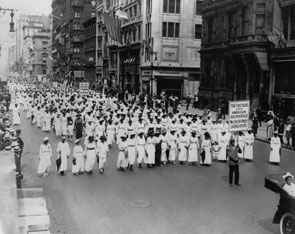The Negroes’ Temporary Farewell
Jim Crow and the Exclusion of African Americans from Congress, 1887–1929
Segregationist Legislation And The Rise Of The NAACP
 Founded in 1909, the National Association for the Advancement of Colored People (NAACP) became a primary advocacy group for early civil rights causes. The 1929 annual meeting in Cleveland, pictured here, included NAACP staff W.E.B. Du Bois, James Weldon Johnson, Walter White, William Pickens, Arthur Spingarn,Image courtesy of Library of Congress
Founded in 1909, the National Association for the Advancement of Colored People (NAACP) became a primary advocacy group for early civil rights causes. The 1929 annual meeting in Cleveland, pictured here, included NAACP staff W.E.B. Du Bois, James Weldon Johnson, Walter White, William Pickens, Arthur Spingarn,Image courtesy of Library of CongressWhen, in 1913, Democrats gained control of Congress and the White House for the first time since the mid-1890s, southern Members of the party were tempted to expand segregation into areas of federal jurisdiction.109 In the first two Congresses of the Woodrow Wilson administration (the 63rd and 64th, 1913–1917), southern Members introduced bills to segregate the federal civil service, the military, and public transportation in Washington, DC. Others introduced bills to repeal the 15th Amendment. Though Congress enacted none of these measures, the significance of these proposals lay in the fact that they were entertained at all. Having solidified absolute control over race issues in the South, southern Members of Congress were sufficiently emboldened to prod Congress to endorse a nationalized racial apartheid.110
Political power brokers in the Capitol and in the Wilson administration harbored segregationist sympathies even if they were unable to promote them by imparting the full weight of federal legislative sanction. In 1913, President Wilson acceded to the wishes of several Cabinet members, who quickly segregated various executive departments. Soon, dining facilities and restrooms throughout the federal government were racially segregated, although not uniformly. Wilson issued no formal executive order, and no laws were enacted, but segregation was tacitly encouraged and widely practiced.111 Congress, which had the responsibility of administering the nation’s capital, did much to promote the practice of segregation in Washington. From 1913 to 1921 and after 1933, southerners largely controlled the panels that appropriated funds and those that dealt with the administrative details of city government. In places where Congress could have overturned Jim Crow practices—in public parks, at Union Station, in theaters, restaurants, and innumerable other locations—it did nothing. Instead, its record in managing the District of Columbia was “profoundly segregationist.”112
 In 1917, New Yorkers silently protested the race riots in East St. Louis, Illinois.Image courtesy of Library of Congress
In 1917, New Yorkers silently protested the race riots in East St. Louis, Illinois.Image courtesy of Library of CongressIn part, the emergence of African-American public advocacy groups such as the NAACP—founded by Mary White Ovington and Oswald Garrison Villard, descendants of prominent abolitionists—counterbalanced efforts to introduce federal segregation laws.113 Although its original organizers were largely white, the NAACP included black intellectuals such as W. E. B. Du Bois, anti-lynching reformer Ida Wells-Barnett, and women’s rights leader Mary Church Terrell, establishing its headquarters in New York City under the leadership of Moorefield Storey, a former president of the American Bar Association. Du Bois soon began publishing The Crisis, the organization’s journal, which served as an outlet for reformers and literary contributors and as a tool to inform the American public about issues critical to African Americans. The NAACP quickly experienced a growth spurt: During World War I, membership swelled 900 percent to include more than 90,000 individuals in 300 cities and towns nationwide. In the 1910s it began a methodical apprenticeship, learning to lobby Congress and to organize national public opinion campaigns.
Footnotes
- Congressional Record, House, 55th Cong., 2nd sess. (26 January 1899): 1125.
- For an exhaustive study on segregation in the federal government, see Desmond King, Separate and Unequal: Black Americans and the US Federal Government (New York: Oxford, 1995): especially pages 9, 20–27.
- See, for example, H.R. 5968 (63rd Congress, 1913–1915), H.R. 7540 (64th Congress, 1915–1917), H.R. 3573 (65th Congress, 1917–1919); King, Separate and Unequal: 218, appendix A1.3.
- From 1914 and lasting until 1940, persons seeking civil service jobs were required to submit a photograph with their application—a de facto method of discrimination based on race and color. Successful African-American job seekers were assigned to a disproportionate number of menial positions (custodial, clerical, and laborer jobs) and very few supervisory positions. See King, Separate and Unequal: 4, 29, 48. As a result, the percentage of African-American civil servants declined from 6 to 4.9 percent of the federal workforce during the Wilson administration, though that figure was somewhat misleading because the actual total increased due to the growth of the federal government during the war production effort. Kendrick A. Clements, The Presidency of Woodrow Wilson (Lawrence: University Press of Kansas, 1992): 45–46, 60–61. See also Joel Williamson The Crucible of Race: Black-White Relations in the American South Since Emancipation (New York: Oxford University Press, 1984). For percentages of African Americans in the federal workforce, see King, Separate and Unequal: 49. Even after Wilson left office, however, discrimination in the federal government remained pervasive. King, Separate and Unequal: 16, 20, 222, 229 (appendices A2.2 and A3.2).
- King, Separate and Unequal: 26–27.
- For a history of the NAACP, see Gilbert Jonas, Freedom’s Sword: The NAACP and the Struggle Against Racism in America, 1909–1969 (New York: Routledge, 2005).

